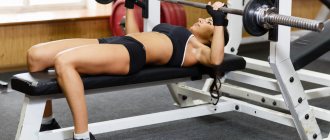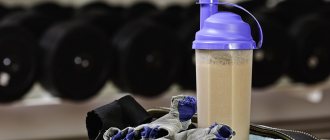Gaining muscle mass is a goal that unites beginners and professional athletes in the gym. A simple desire that requires a lot of effort - a combination of proper nutrition and a well-structured training split.
Huge, defined muscles - it certainly looks beautiful, impressive, if we talk about large volumes. To impress others with your form, check out the mass gain training program and recommendations presented in this article.
Rules for gaining muscle mass
It is not easy to increase impressive volumes, even if you devote yourself entirely to what you love. You have to work hard in and outside the gym to achieve a beautiful body. In particular, this applies to nutrition, training split and daily routine. It will be most difficult for ectomorphs - they will have to eat a lot and work hard.
Note that gaining large amounts of pure muscle mass is much more difficult than losing excess weight. Gaining mass lasts longer, during this period you have to give it your all in the gym, eating through force.
There are several ways to provoke abundant muscle growth. Of course, this does not include mindlessly lifting the barbell at random amplitudes without a fixed number of repetitions or time under load. Over the years, bodybuilding has developed its own principles that have proven their effectiveness. They help athletes from all over the world build muscle mass.
Basic exercises for gaining muscle mass
Basic exercises are what can build beautiful, powerful muscles of an athlete. They should not be neglected - all mass training splits include basic exercises that involve the maximum number of muscles in one movement.
The most understandable example of basic exercises is the chest press on a horizontal bench, deadlift and squats with a barbell on the shoulders. "Powerlifting trio"
uses all the muscles of the human body.
- Squats work the quadriceps, hamstrings, and glutes.
- During a bench press, the entire shoulder girdle comes into play: the pecs, deltoids, lats, triceps, biceps and abs act as stabilizers.
- Deadlift - it uses about 70% of the muscles of the whole body: quadriceps, hamstrings, glutes, lats, lower back, upper back, forearms, abs.
All three exercises are performed with heavy weights. This is facilitated by the number of muscle groups involved.
Working with maximum weights provokes muscle growth.
You cannot perform all three exercises on the same day - this may lead to overtraining. In a classic mass training split, one of the exercises comes first in the program for the day. After completing the base, you should start isolating, but not vice versa.
Basic exercises are the most difficult and energy-consuming. It is recommended to take a relatively long rest between sets - about 1-4 minutes, depending on the level of the athlete and the exercise being performed.
THE MAIN advantage of basic exercises
Note! The total training time (productively) should not exceed the one hour mark. The optimal time for classes is 40-60 minutes. Otherwise, the athlete may “catch” overtraining, or provoke muscle burning.
Men's training program for gaining muscle mass (amateur level)
Day 1
Muscle groups trained: Chest, Biceps
- Warm up 5 minutes
- Bench press
- Incline Dumbbell Press 30*
- Wide grip dips
- Standing biceps curl
- Lifting dumbbells alternately for biceps while standing
Day 2
Muscle groups trained: Back, Triceps
- Warm up 5 minutes
- Pull-ups on the horizontal bar with a wide grip to the chest
- Belt barbell row
- Sitting vertical block row to the chest
- Horizontal block pull to the belt
- French bench press with barbell
- standing arm extension (triceps)
Day 3
Muscle groups trained: Shoulders, Legs
- Warm up 5 minutes
- Seated dumbbell press
- Standing dumbbell lateral raises
- Standing barbell row to the chin (medium grip)
- Barbell Squats / Platform Leg Press / Smith Machine Squats
- Seated leg extensions
- Sitting/standing calf raises in the machine
Exercises are performed in 4 sets of 8 to 10 repetitions. Rest between sets is 1.5 - 2 minutes, between exercises 3 - 4 minutes. The total training duration is no more than 60 minutes. The press is done as needed. 3 workouts per week in a cycle from 3 to 6 months. Training weights are moderate and are selected individually for each approach.
Projectile weight, approaches and repetitions for weight
The most advantageous repetition range for gaining muscle mass is from 6 to 12 in one set. Based on this, you should decide on the weight. The athlete should comfortably work with the apparatus for 3 working approaches, if you do not take into account the warm-up.
By the last repetition of the last approach, you should feel tired and tense. In this case, a training partner will come in handy more than ever.
Chasing weight is a mistake that beginner athletes make. The recipe for a pumped-up, massive torso is technically correctly performed exercises, in full amplitude. Control every step of the movement.
How many reps do you need to do to grow muscles?
Work to failure on the last rep of the extreme set. Don’t relax, because it’s failure repetitions that provoke abundant muscle growth. Use the help of an insurer.
The first stage of rapid weight gain
This phase is called “three sixes” because it involves performing 6 exercises in 6 sets of 6 repetitions per workout. In each exercise, the athlete must reach failure, but only in the last repetition, that is, the athlete trains according to the pyramid principle, increasing weight gradually. This phase lasts 4 weeks, during which the athlete must complete 12 workouts, training every other day. Rest between approaches is 60-90 seconds, despite the fact that the athlete uses the pyramid principle, it is necessary to warm up. Since it is almost impossible to withstand such a volume of training with a weight of more than 80 kg without the use of pharmacology, athletes with such a weight need to break the training into 2 parts (workout A and workout B), alternating them every training day. Accordingly, if you perform 3 exercises per workout, then you need to complete 16 workouts per cycle, so it will last 4.5 weeks.
A) Standing barbell chest press – 6 sets of 6 reps A) Bench press – 6 sets of 6 reps A) Classic deadlift – 6 sets of 6 reps B) Bent-over barbell row – 6 sets of 6 reps B) Biceps curl standing with a barbell - 6 sets of 6 reps B) Classic squats with a barbell - 6 sets of 6 reps
IMPORTANT * at the end of the first phase, the athlete must completely rest from training for 7-14 days! It is recommended to take creatine, taking a break between phases; The amount of food is not limited, you need to eat as much as possible.
Stage 2 of the Muscle Gain Plan
The second phase is called “alternating course” , since the athlete switches from circuit training to split training, and the repetition and approach regime also changes. An athlete should train 3 times a week, every other day, with 2 days rest between weeks. Rest time between sets is 60-90 seconds. The duration of the second phase is also 4 weeks, during which the athlete must complete 12 workouts. The athlete does fewer approaches per workout, so the CP decreases, but the number of repetitions in the approaches is from 10 to 2. This means that the athlete is already working not only on developing strength indicators, but is also training the nervous system.
It goes without saying that in each exercise the failure repetition is only the last, and in those exercises where the range of repetitions is indicated, it is meant that in the first approach the athlete must do the maximum number of repetitions, and in the last the minimum. In all other approaches, the athlete gradually reduces the number of repetitions and increases the weight, independently deciding how many repetitions to do, but in the first approach he must do the maximum number of repetitions, and in the last he must reach failure in the minimum number of repetitions. This is necessary because it is in this mode that you will gain weight the fastest!
Workout No. 1 Squats with a barbell on the shoulders - 6 sets of 10-2 reps Dips on the parallel bars - 4 sets of 8 reps Power press - 6 sets of 8-2 reps Bent-overs with a barbell - 3 sets of 8 reps Bent-over rows - 4 sets of 8 reps Standing biceps curls – 4 sets of 10-6 reps
Workout No. 2 Bench press – 6 sets of 10-4 reps Barbell cleans – 3 sets of 6-3 reps Deadlift – 6 sets of 8-3 reps Seated overhead press – 3 sets of 8 reps Press legs – 4 sets of 8 reps
Workout No. 3 Hyperextension – 3 sets of 10 reps Deadlift – 5 sets of 8-3 reps Angle press – 5 sets of 8 reps Lav rows – 4 sets of 8 reps Classic barbell squats – 5 sets of 10 reps 4 reps
IMPORTANT * at the end of the second phase, the athlete must completely rest from training for 7-14 days! It is recommended to take creatine supplements with a break between phases; The amount of food is not limited, you need to eat as much as possible.
Train with free weights
Free muscle movement without isolation within a certain amplitude is another secret to gaining muscle mass. It turns out that if the athlete’s goal is to acquire impressive volumes, it is better to trust exercises with free weights, and relegate exercise machines to the background.
Exercises with barbells and dumbbells involve the maximum number of muscle fibers, including auxiliary, stabilizer muscles. This helps to gain high-quality muscle mass.
Free weights or machines?
When working with a barbell or dumbbells, try to gradually increase the weight of the apparatus. The body tends to adapt - therefore, if you constantly give the same load, the process will stop. Under no circumstances allow your muscles to adapt!
Recovery after training
Beginners are mistaken in believing that the key to muscle growth lies only in proper training. In fact, to create the body of your dreams, you will need to follow a routine and get enough rest. Remember - muscles do not grow in the gym, but in breaks between classes, during the recovery process.
The optimal number of workouts per week for gaining weight is 3; if the body does not have time to renew its strength, it can be reduced to 2. It is important to know that large muscle groups recover in approximately 72 hours, small ones – 48. But keep in mind that each person is individual.
The goal of training in the gym is to cause microtrauma to the muscles. That's why volumes only increase during rest - muscle fibers gradually heal, recover, become larger and stronger.
How to properly recover after training
Don't forget about your sleep schedule: proper training is good, but your sleep schedule is no less important. Therefore, you need to ensure that you get adequate sleep. Lack of sleep inhibits muscle growth.
Nutrition for gaining muscle mass
Nutrition is one of the keys to building a massive, toned torso. After all, everything a person eats serves as the foundation for his body. First of all, it’s worth thinking about the daily intake of dietary fat: proteins, fats and carbohydrates.
Carbohydrates are energy for our body, and protein is material for building muscles. Depending on the athlete’s size and weight, daily calorie consumption ranges from 2500 to 4000 during the period of mass gain. Nutritionists and experienced athletes recommend giving preference to slow carbohydrates in the first half of the day, and protein-rich foods in the second.
Read also: Chicken breast dishes
If counting the amount of BJU is difficult for you, remember a few simple rules necessary for gaining muscle mass
:
- carbohydrates must be complex;
- you should give up flour and sweets;
- The main carbohydrate intake should be in the first half of the day.
When choosing carbohydrates, the best choice for bulking would be
:
- Durum pasta
- Buckwheat
- Steamed rice
- Baked potatoes with skins
- Wholemeal bread (with bran)
The Best Natural Sources of Protein for Mass Gain
:
- Chicken eggs;
- Meat: chicken breasts, beef tenderloin or chop;
- Fish: salmon, salmon, trout, mackerel, flounder, any budget version of fish with OMEGA-3;
- Cottage cheese.
Read also: Nutrition program for weight gain
You can't build your dream body through exercise alone. Nutrition plays a key role in gaining muscle mass.
Daily diet for gaining muscle mass
Meals should be taken about 5-6 times, at intervals of 3-4 hours. They should include: about 2 grams of protein per 1 kg of a person’s weight, as well as a sufficient amount of carbohydrates to provide energy for the whole day and workout.
The third stage of gaining weight quickly
The third phase is called “impact split” , since this stage allows you to load almost all muscular and non-muscular systems of the body. You will be able to restore the capillary network, work on strength indicators, load the nervous system and pump up the myofibrillar apparatus. In other words, all the previous phases were just a lead-up to the third, which will ensure rapid weight gain. The rules here are the same as in the previous phase, with the exception of the training schedule and the number of approaches. Athletes weighing up to 80kg can train 4 times a week 2 through 1, that is, 2 training sessions in a row, a rest day and 2 training sessions in a row. Athletes with larger masses can train simply every other day, with rest every 4 training sessions in 2 days. In total, you need to complete 20 workouts per cycle. The range of approaches allows you to choose the number of approaches depending on how you feel.
Workout No. 1 Strength bench press – 8-10 sets of 15-1 reps Barbell squats – 8-10 sets of 15-2 reps Dips – 5 sets of 5 reps
Workout No. 2 Barbell cleans – 2 sets of 5 reps Deadlifts from plates * – 6-8 sets of 6-8 reps Standing barbell chest press – 4 sets of 4 reps Wide-grip pull-ups – 5-6 sets of 8- 6 reps Dumbbell flyes – 3 sets of 6 reps Cable arm extensions – 3 sets of 8 reps
Workout No. 3 Barbell squats – 8-10 sets of 15-1 reps Power bench press – 6-8 sets of 8-2 reps Overhead push-ups – 5 sets of 8-3 reps
Workout #4 Deadlift – 4 sets of 10-4 reps Leg press – 5 sets of 8 reps Bent-over rows – 3 sets of 6 reps Angle press – 4 sets of 6 reps Standing biceps curls – 5 sets of 8 reps
IMPORTANT* at the end of the third phase, the athlete must completely rest from training for 7-14 days! It is recommended to take creatine supplements with a break between phases; The amount of food is not limited, you need to eat as much as possible.
Deadlift from plates* is a classic deadlift, in which the barbell is placed on a hill, about 7-10cm higher than usual, that is, the athlete simply works in a shorter amplitude.
Stage 4 of the Rapid Weight Gain Plan
The final stage of the program for rapid mass gain is called “three tens” , since the athlete will have to complete 9 circuit training sessions over three weeks, consisting of 3 exercises performed in 10 sets of 10 repetitions. After this phase, the program ends, but, we emphasize , at the end of it you need to rest for 14-21 days, after which you will engage in some kind of recovery program for 2 months, such as a three-day split or a pumping program. Then you should rest for another 1-2 weeks and you can switch to the Plintovich system.
Back squats – 10 sets of 10 reps Bench press – 10 sets of 10 reps Bent-over rows – 10 sets of 10 reps
IMPORTANT* at the end of the fourth phase, the athlete must completely rest from training for 14-21 days! It is recommended to take creatine, taking a break between phases; The amount of food is not limited, you need to eat as much as possible.
Training programs for the gym











